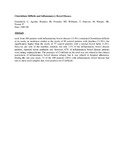Prevalence of Clostridium difficile infections among Kenyan children with diarrhea.

View/
Date
2019Author
Plants-Paris, K
Bishoff, D
Oyaro, MO
Mwinyi, B
Chappell, C
Nyangao, J
Mbatha, D
Darkoh, C
Type
ArticleLanguage
enMetadata
Show full item recordAbstract
BACKGROUND:
Diarrhea causes significant morbidity and mortality among children worldwide. Regions most affected by diarrhea include Sub-Saharan Africa and Southeast Asia, where antibiotics are in common use and can make children more vulnerable to Clostridium difficile and pathogens that are not affected by these drugs. Indeed, C. difficile is a major diarrhea-associated pathogen and poses a significant threat to vulnerable and immunocompromised populations. Yet, little is known about the role and epidemiology of C. difficile in diarrhea-associated illness among young children. As a result, C. difficile is often neglected in regions such as Sub-Saharan Africa that are most impacted by childhood diarrhea. The purpose of this study was to establish the frequency of C. difficile in young children (<5 years) with diarrhea.
METHODS:
Children presenting with diarrhea at a national hospital in Kenya from 2015 to 2018 were enrolled consecutively. Following informed consent by a parent or legal guardian, stool samples were obtained from the children and demographic data were collected. The stools were examined for the presence of four common pathogens known to cause diarrhea: C. difficile, rotavirus, Cryptosporidium parvum, and Giardia lamblia. C. difficile was verified by toxigenic culture and PCR. The presence of C. parvum and/or G. lamblia was determined using the ImmunoCard STAT! Crypto/Giardia Rapid assay. Rotavirus was detected by ELISA.
RESULTS:
The study population comprised 157 children; 62.4% were male and 37.6% were female and their average age was 12.4 months. Of the 157 stool specimens investigated, 37.6% were positive for C. difficile, 33.8% for rotavirus, 5.1% for Cryptosporidium, and 5.1% for Giardia. PCR analysis identified at least one of the C. difficile-specific - genes (tcdA, tcdB, or tcdC). Further, 57.6% of the stools had C. difficile colonies bearing a frame-shift deletion in the tcdC gene, a mutation associated with increased toxin production. The frequency of C. difficile was 32.6% in children ≤12 months old and increased to 46.6% in children 12-24 months old.
CONCLUSIONS:
In Kenyan children presenting with diarrhea, C. difficile is more prevalent than rotavirus or Cryptosporidium, two leading causes of childhood diarrhea. These findings underscore the need to better understand the role of C. difficile in children with diarrhea, especially in areas with antibiotic overuse. Understanding C. difficile epidemiology and its relationship to co-infecting pathogens among African children with diarrhea will help in devising ways of reducing diarrhea-associated illness.
Copyright © 2019 The Authors. Published by Elsevier Ltd.. All rights reserved.
Publisher
University of Nairobi
Collections
- Faculty of Health Sciences (FHS) [10415]
Related items
Showing items related by title, author, creator and subject.
-
Clostridium Difficile And Inflammatory Bowel Disease.
Greenfield, C; Aguilar, Ramirez JR; Pounder, RE; Williams, T; Danvers, M; Marper, SR; Noone, P (University of NairobiFaculty of medicine, 1983-08)tools from 109 patients with inflammatory bowel disease (13.4%) contained Clostridium difficile or its toxin, an incidence similar to the stools of 99 control patients with diarrhoea (11.9%), but significantly higher than ... -
High rate of Clostridium difficile among young adults presenting with diarrhea at two hospitals in Kenya.
Oyaro, MO; Plants-Paris, K; Bishoff, D; Malonza, P; Gontier, CS; DuPont, HL; Darkoh, C (University of Nairobi, 2018)BACKGROUND: Clostridium difficile infection (CDI) is the leading cause of antibiotic-associated diarrhea worldwide. As a result, the US Centers for Disease Control and Prevention have designated C. difficile as an urgent ... -
Isolation and Characterization of Toxigenic Clostridium Difficile in Selected Outpatient Health Facilities Within Nairobi County
Maina, Ruth W (University of Nairobi, 2020)Background In the last four decades, the spectrum encompassing the epidemiology and management of Clostridium difficile associated diseases (CDAD) has changed progressively. These changes resonate with heightened rates ...

